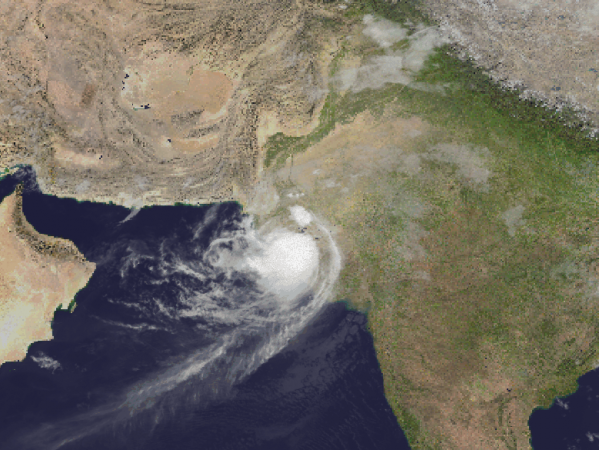
New Delhi: Cyclone Biparjoy pushed ashore in western India and southern Pakistan, pelting the coastlines with wind-driven rain and the threat of significant storm surge and flash floods.
Prior to the cyclone, the two countries relocated 173,000 people to shelters, and plans were made to continue communications and supply water once the storm passed. The path of the cyclone passes through Sindh, a province in southern Pakistan that was devastated by floods last summer.
On Thursday, dust storms made it difficult to evacuate people and carry out rescue operations on land while the skies darkened along the Arabian Sea. Biparjoy was expected to weaken as it moved into Gujarat state in India. It had maximum sustained winds of 120 kph (75 mph) and gusts as high as 140 kph (86 mph).
Also Read: Increasing Israeli settler violence against Palestinians requires international action
Authorities in India's Kutch district, close to Jakhau port, where the cyclone made landfall, were preparing for a sizable sea surge. Additionally in Biparjoy's path is Keti Bandar in the Sindh province of Pakistan. By midnight, the cyclone was expected to approach Pakistan's southern coastal regions.
Due to government shutdown orders, the beaches and bazaars in Mandvi, India, a typically busy coastal town known for its wooden boat-makers, were deserted on Thursday. Some trees in the area had already been uprooted by strong winds and rain.
displaced families were visibly shocked at relief camps in southern Pakistan amid dust storms and rain. Bachai Bibi, an 82-year-old evacuee from Sindh's Badin district, said, "I don't know what will happen to my home."
The 35-year-old Mohammad Ashraf claimed that local authorities assisted him, his wife, and their three children in leaving the Pakistani village of Sheikh in the storm's path.
100,000 people gathered in relief camps in India to wait out the storm. According to Lt. Gen. Inam Haider Malik, head of the National Disaster Management Authority, 73,000 people in Pakistan have been relocated to safer areas where authorities are providing them with food and shelter.
Also Read: UN agencies warn of 'enormous' needs as the EU hosts a meeting to raise money for Syria.
Last summer, 33 million people were forced to flee their homes due to historic floods in Pakistan's Sindh province that were caused in part by climate change.
The World Health Organisation declared that it was assisting Pakistan in its efforts to mitigate the cyclone's effects. People who had been displaced in Pakistan received free food and clean water from the government and local aid organisations.
Shahbaz Sharif, the prime minister of Pakistan, tweeted on Wednesday that his administration had taken all feasible steps to ensure the safety of those in southern Sindh province who were at risk.
Due to rain and strong winds in Karachi, "preparations have been made to handle any kind of emergency, while the evacuation of fishermen from the sea and the population on the coastal areas is going on rapidly," he said.
Rushikesh Patel, the health minister for the state of Gujarat, told the Press Trust of India that extensive preparations had been made "for post-cyclone work like restoration of electricity infrastructure, mobile networks, and other infrastructure."
Numerous trains were cancelled and India closed religious sites in Gujarat's coastal region.
Low-lying areas will likely be flooded by a storm surge that is 2 to 3 metres (6.5 to 10 feet) above the tide, and in some places it could even reach 6 metres (19.5 feet).
The Gujarat State Disaster Management Authority employed six ham radio teams across coastal districts to maintain communications because cyclones frequently disrupt mobile networks.
Ham radios allow us to communicate emergency requirements without the need for mobile towers, electricity or the Internet. When a disaster like this strikes, they are incredibly helpful, ham radio operator Kausal Jani told PTI.
Also Read: Vatican: Pope Francis is anticipated to leave the hospital within a few days
More than 625,000 children in the two countries were at immediate risk, UNICEF warned. Noala Skinner, UNICEF's regional director for South Asia, stated that Cyclone Biparjoy in Pakistan "threatens a new crisis for children and families in Sindh, the province worst affected by last year's devastating floods."
The frequency, duration, and intensity of cyclones in the Arabian Sea increased significantly between 1982 and 2019, according to a 2021 study, and experts predict the increase will continue, making it more urgent to make plans for natural disasters